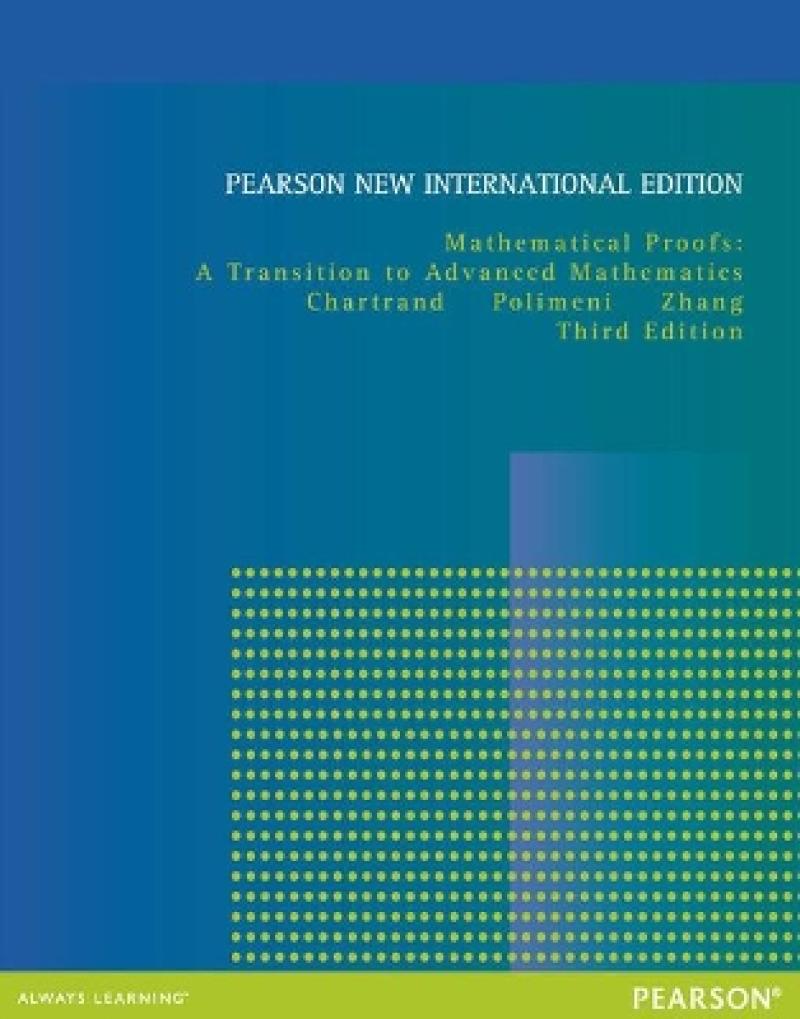0. Communicating Mathematics
Learning Mathematics
What Others Have Said About Writing
Mathematical Writing
Using Symbols
Writing Mathematical Expressions
Common Words and Phrases in Mathematics
Some Closing Comments About Writing
1. Sets
1.1. Describing a Set
1.2. Subsets
1.3. Set Operations
1.4. Indexed Collections of Sets
1.5. Partitions of Sets
1.6. Cartesian Products of Sets
Exercises for Chapter 1
2. Logic
2.1. Statements
2.2. The Negation of a Statement
2.3. The Disjunction and Conjunction of Statements
2.4. The Implication
2.5. More On Implications
2.6. The Biconditional
2.7. Tautologies and Contradictions
2.8. Logical Equivalence
2.9. Some Fundamental Properties of Logical Equivalence
2.10. Quantified Statements
2.11. Characterizations of Statements
Exercises for Chapter 2
3. Direct Proof and Proof by Contrapositive
3.1. Trivial and Vacuous Proofs
3.2. Direct Proofs
3.3. Proof by Contrapositive
3.4. Proof by Cases
3.5. Proof Evaluations
Exercises for Chapter 3
4. More on Direct Proof and Proof by Contrapositive
4.1. Proofs Involving Divisibility of Integers
4.2. Proofs Involving Congruence of Integers
4.3. Proofs Involving Real Numbers
4.4. Proofs Involving Sets
4.5. Fundamental Properties of Set Operations
4.6. Proofs Involving Cartesian Products of Sets
Exercises for Chapter 4
5. Existence and Proof by Contradiction
5.1. Counterexamples
5.2. Proof by Contradiction
5.3. A Review of Three Proof Techniques
5.4. Existence Proofs
5.5. Disproving Existence Statements
Exercises for Chapter 5
6. Mathematical Induction
6.1 The Principle of Mathematical Induction
6.2 A More General Principle of Mathematical Induction
6.3 Proof By Minimum Counterexample
6.4 The Strong Principle of Mathematical Induction
Exercises for Chapter 6
7. Prove or Disprove
7.1 Conjectures in Mathematics
7.2 Revisiting Quantified Statements
7.3 Testing Statements
Exercises for Chapter 7
8. Equivalence Relations
8.1 Relations
8.2 Properties of Relations
8.3 Equivalence Relations
8.4 Properties of Equivalence Classes
8.5 Congruence Modulo n
8.6 The Integers Modulo n
Exercises for Chapter 8
9. Functions
9.1 The Definition of Function
9.2 The Set of All Functions from A to B
9.3 One-to-one and Onto Functions
9.4 Bijective Functions
9.5 Composition of Functions
9.6 Inverse Functions
9.7 Permutations
Exercises for Chapter 9
10. Cardinalities of Sets
10.1 Numerically Equivalent Sets
10.2 Denumerable Sets
10.3 Uncountable Sets
10.4 Comparing Cardinalities of Sets
10.5 The Schröder-Bernstein Theorem
Exercises for Chapter 10
11. Proofs in Number Theory
11.1 Divisibility Properties of Integers
11.2 The Division Algorithm
11.3 Greatest Common Divisors
11.4 The Euclidean Algorithm
11.5 Relatively Prime Integers
11.6 The Fundamental Theorem of Arithmetic
11.7 Concepts Involving Sums of Divisors
Exercises for Chapter 11
12. Proofs in Calculus
12.1 Limits of Sequences
12.2 Infinite Series
12.3 Limits of Functions
12.4 Fundamental Properties of Limits of Functions
12.5 Continuity
12.6 Differentiability
Exercises for Chapter 12
13. Proofs in Group Theory
1
- Proof Strategies encourage students to plan what is needed to present a proof of the result in question.
- Proof Analysis segments appear after presentations of proofs and discuss key details considered for the creation of each proof.
- Chapter 0, Communicating Mathematics provides a valuable reference for students as the course progresses. This chapter prepares students to write effective and clear exposition by emphasizing the correct usage of mathematical symbols, mathematical expressions, and key mathematical terminology.
- Early introduction of Sets (Chapter 1) prepares students for the coverage of logic that follows.
- Early introduction of Logic (Chapter 2) presents the needed prerequisites to get into proofs as quickly as possible. Much of the chapter’s emphasis is on statements, implications, and an introduction to qualified statements.
- Proof by Contradiction receives an entire chapter, with sections covering counterexamples, existence proofs, and uniqueness.
- A wide variety of exercises is provided in the text.
- Difficulty ranges from routine to medium to moderately challenging
- True/False exercises present statements and ask students to determine whether they are correct, asking for justification as part of the process.
- Proposed proofs of statements ask students if an argument is valid.
- Proofs without a statement ask students to supply a statement of what has been proved.
- Finally, there are exercises that call upon students to ask questions of their own and to provide answers.
- New Exercises: More than 250 exercises have been added, including many challenging exercises at the end of exercise sets. New exercises include some dealing with making conjectures to give students practice with this important aspect of advanced mathematics.
- New and Revised Examples: Examples have been added and heavily revised with new proofs, adding support for the material to give students better understanding and helping them to solve new exercises.
- Additional sections: Chapter 13 has been expanded to include coverage of cosets and Lagrange’s theorem. The important topic of quantified statements is now introduced in Section 2.10 and reviewed in Section 7.2 in reinforce the student’s understanding.
